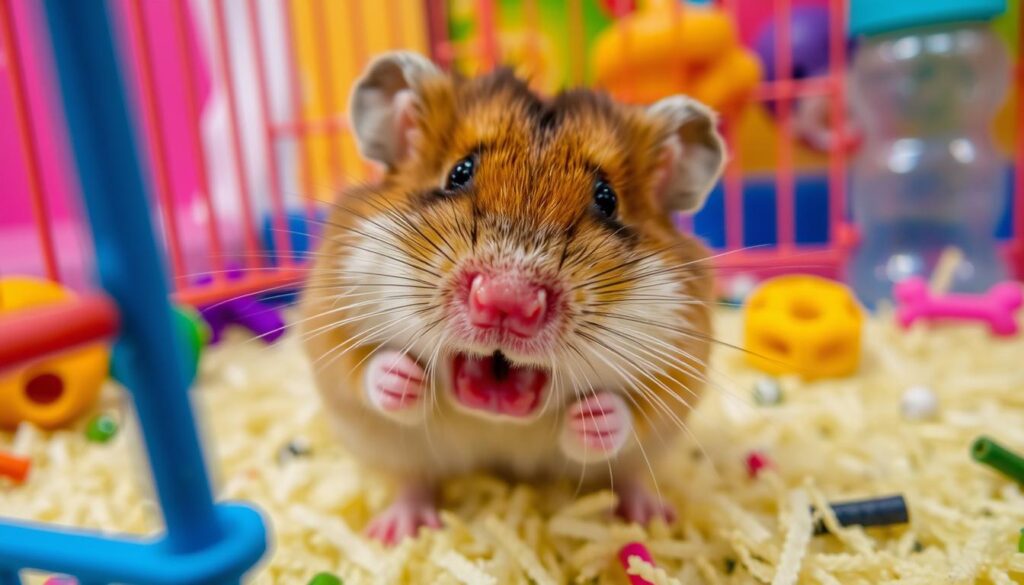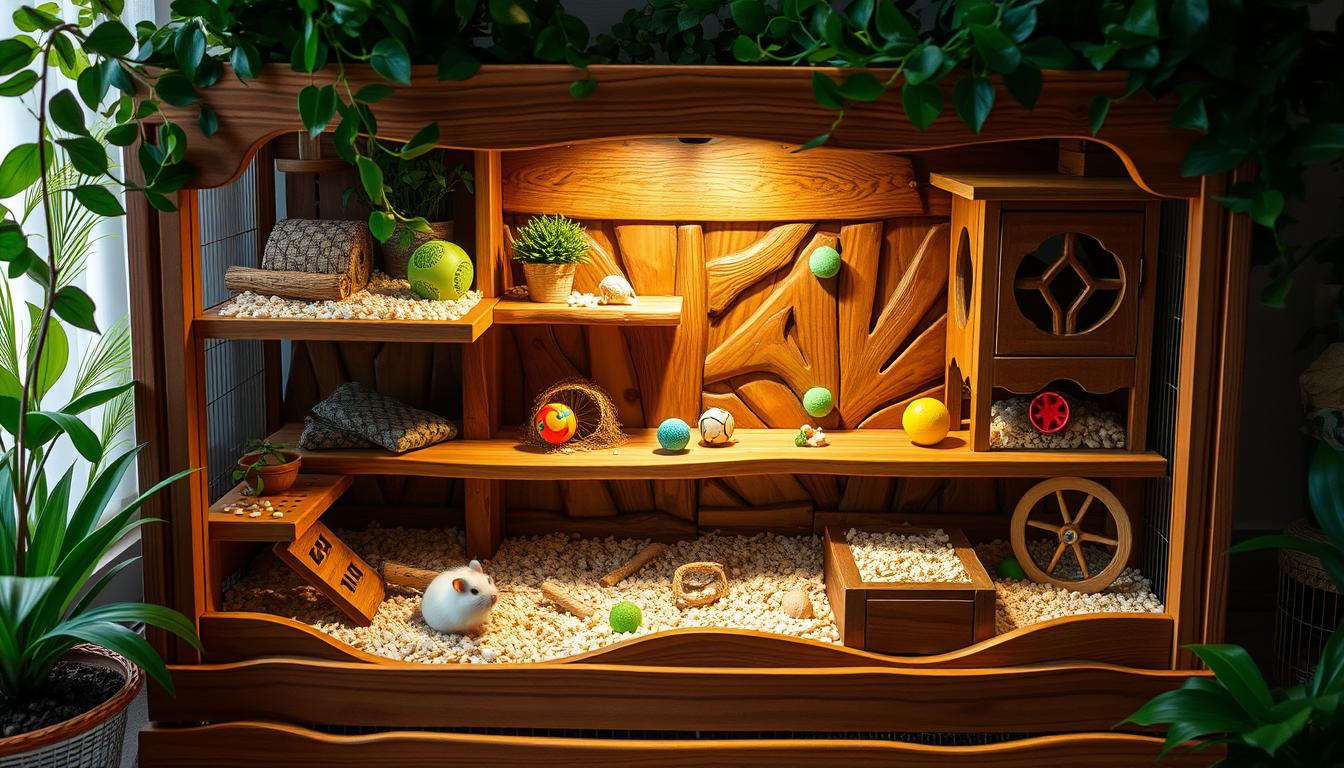Have you seen your hamster chewing on the cage bars? It’s a common problem for hamster owners. But, knowing why they do it is the first step to fixing it. We’ll look at why they chew on the cage and how to stop it. This will help keep your hamster happy and healthy.
Key Takeaways
- Discover the natural instincts and factors that can trigger cage-biting in hamsters.
- Identify the root causes of your hamster’s cage-biting behavior.
- Learn how to create a stimulating environment and manage stress to curb this habit.
- Understand the importance of dental health and provide appropriate chewing alternatives.
- Develop effective strategies to address cage-biting and ensure your hamster’s overall well-being.
Why does your hamster keep chewing on the cage? Is it boredom, stress, or something else? Let’s find out together. We’ll explore the reasons and solutions to this common problem. This way, you can keep your hamster happy and healthy.
Understanding Hamster Behavior
To understand why your hamster bites the cage, we need to know their natural behaviors. Hamsters are curious, active, and love to explore. In the wild, they forage, burrow, and chew to keep their teeth from growing too long.
Exploring the Natural Instincts of Hamsters
Hamsters have instincts that are part of their DNA. They are natural burrowers, making complex tunnel systems for their homes. This urge to dig and explore can make them chew on cage bars or walls, trying to make their space bigger.
Factors That Influence Cage-Biting Behavior
- Boredom: Hamsters need mental and physical stimulation to avoid boredom. This can lead to cage-biting.
- Stress and Anxiety: Loud noises, frequent disturbances, or poor living conditions can stress hamsters. They may bite the cage as a way to cope.
Knowing hamsters’ natural instincts and behaviors helps us understand why they bite the cage. We can then take steps to stop it, keeping our furry friends happy and healthy.
“Hamsters are natural burrowers, often creating intricate tunnel systems to create their homes.”
Potential Reasons for Cage-Biting
Hamsters are curious and active. Without enough to do, they might chew on their cage. This is a way to fight boredom and stress. Knowing why they do this helps owners make their pets’ lives better.
Boredom and Lack of Stimulation
Boredom in hamsters often comes from not enough to do. They love to forage, nest, and explore. Without these chances, they chew on their cage to release their energy and curiosity.
Stress and Anxiety
Stress in hamsters can make them chew a lot. Things like a bad environment, wrong handling, or routine changes can stress them out. Fixing these issues is key to making your hamster happier and less stressed.

“A bored hamster is a destructive hamster. Providing plenty of enrichment activities and toys can help prevent cage-biting and keep your pet happy and healthy.”
Understanding why hamsters chew on their cages helps owners. They can make their pets’ lives better. This reduces bad behaviors and makes hamsters happier and healthier.
Dental Health and Chewing Needs
Keeping your hamster’s teeth healthy is key to their care. Hamsters’ teeth grow all the time. They chew to keep their teeth from getting too long. If they can’t chew enough, they might bite their cage.
Hamsters need to grind their teeth, which is good for their dental health. To help, give them chew toys and other things to bite on.
| Chewing Material | Benefits |
|---|---|
| Wooden blocks | Help wear down teeth and satisfy the natural chewing instinct |
| Hay and hay cubes | Provide fibrous material that promotes healthy teeth and gums |
| Cardboard tubes | Offer a safe, natural chewing option and environmental enrichment |
| Apple sticks | Contain natural enzymes that help maintain dental health |
Offering different chewing materials is vital for your hamster’s dental health. It also stops them from biting the cage too much. Watch them and change what they chew to keep their teeth healthy.
“Providing your hamster with ample chewing opportunities is essential for their dental well-being and overall health.”
Why Is My Hamster Biting the Cage?
As a pet owner, seeing your hamster bite the cage can worry you. It’s key to know why they do this. This way, you can fix the problem and keep your hamster happy.
Identifying the Root Cause
To figure out why your hamster bites the cage, watch their behavior closely. Notice when and how often they chew. Also, look for things that might make them do it. Hamster behavior can change for many reasons. Knowing why is the first step to solving the problem.
Observing Behavioral Patterns
Keep an eye on these things about your hamster’s behavior:
- When does the cage-biting happen? Is it at certain times or all the time?
- How hard do they chew? Is it a light nibble or a strong gnaw?
- Are there any big changes or stressors before they start biting the cage?
By watching your hamster’s behavior, you can find out why they bite the cage. Then, you can make a plan to help them.
Understanding why your hamster bites the cage is the first step to solving it. Keep watching, learn from their actions, and make sure they have a fun and safe place to live.

Providing a Stimulating Environment
Creating a stimulating environment for your hamster is key to stop cage-biting. By meeting their natural instincts and needs, you can guide their energy into positive activities.
Enrichment Activities and Toys
Hamsters are curious and love to move. So, it’s important to give them lots of toys and activities. Here are some ideas:
- Tunnels and hideaways for burrowing and nesting
- Chew toys made of safe materials like wood or untreated cardboard to satisfy their natural need to gnaw
- Climbing structures and platforms to explore and exercise
- Foraging opportunities, such as scatter-feeding their diet or hiding treats throughout the cage
- Dust baths for grooming and keeping their coat healthy
Cage Setup and Accessories
The setup of your hamster’s cage is also crucial. Make sure it’s big enough and has lots of bedding for burrowing. Add these accessories to make their space better:
- Sturdy, chewable toys and structures for climbing and exploration
- Soft, comfortable nesting material like hay or shredded paper
- A wheel for exercise and mental stimulation
- Hiding spots and shelters to allow your hamster to feel secure
By making their environment rich and engaging, you can meet their natural behaviors. This can help prevent cage-biting. Happy and active hamsters are less likely to bite their cage.
Managing Stress and Anxiety
Creating a fun environment for your hamster is important. But, you also need to deal with stress and anxiety. Things like their environment, how you handle them, and their social life can affect their mood. These factors can make them chew on their cage.
Environmental Factors
Make sure your hamster’s home is quiet and the right temperature. Avoid loud noises and sudden changes. A calm, steady environment helps your hamster feel safe and happy.
Handling and Socialization
Handling your hamster right and socializing them slowly is key. Start by letting them get used to you. Move slowly and gently to avoid scaring them. With time, your hamster will trust you more and enjoy being around people.
By tackling stress in hamsters and making their home peaceful, you can stop cage-biting. This improves their hamster behavior and happiness.
Addressing Dental Issues
Keeping your hamster’s teeth healthy is key to stopping cage-biting. Hamsters’ teeth grow all the time and need to be chewed to stay short and healthy. If they don’t get enough chewing, they might bite the cage to wear down their teeth.
Chew Toys and Alternatives
Give your hamster safe, tough chew toys to meet their chewing needs. Wooden blocks, hay cubes, and hamster chew toys are great choices. These let your hamster chew and keep their teeth in check while they play.
Watching your hamster’s teeth and fixing any problems quickly is important. This keeps them happy and healthy, and stops cage-biting. A good dental care routine is vital for your hamster’s happiness and health.




